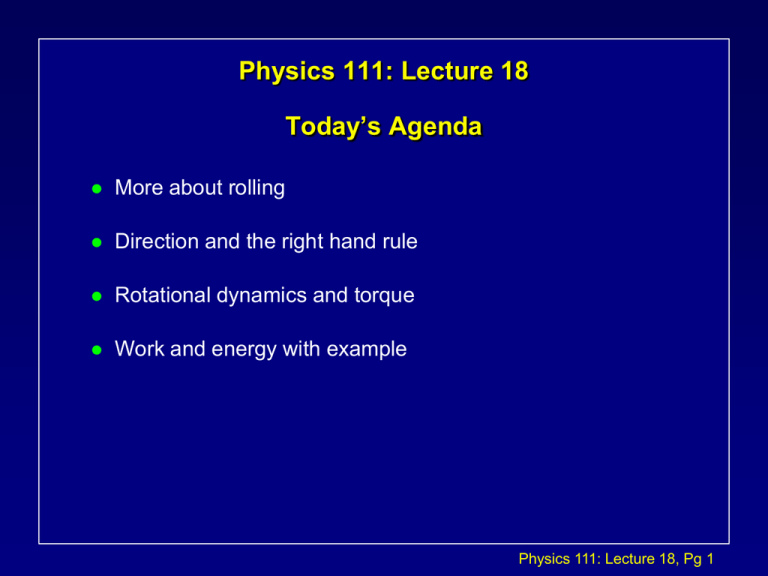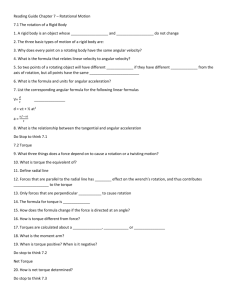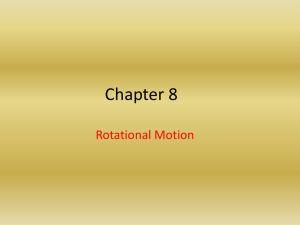Physics 106P: Lecture 22 Notes
advertisement

Physics 111: Lecture 18 Today’s Agenda More about rolling Direction and the right hand rule Rotational dynamics and torque Work and energy with example Physics 111: Lecture 18, Pg 1 Rotational v.s. Linear Kinematics Angular Linear = constant a cons tan t = 0 + t v = v 0 + at 1 2 = 0 + 0 t + t 2 1 x = x 0 + v 0 t + at 2 2 And for a point at a distance R from the rotation axis: x = R v = R a = R Physics 111: Lecture 18, Pg 2 Roll objects Rolling Motion Cylinders of different I rolling down an inclined plane: R M h down ramp v=0 =0 K=0 K = - U = Mgh 1 2 1 K = I + Mv 2 2 2 v = R Physics 111: Lecture 18, Pg 3 Rolling... If there is no slipping: v In the lab reference frame 2v v v Where v = R In the CM reference frame Physics 111: Lecture 18, Pg 4 Rolling... 1 2 1 K = I + Mv 2 2 2 K= So: Use v = R and I = cMR2 . 1 1 1 c MR 2 2 + Mv 2 = ( c + 1)Mv 2 2 2 2 1 ( c + 1)Mv 2 = Mgh 2 hoop: c=1 disk: c = 1/2 sphere: c = 2/5 etc... v = 2 gh 1 c +1 The rolling speed is always lower than in the case of simple sliding since the kinetic energy is shared between CM motion and rotation. We will study rolling more in the next lecture! Physics 111: Lecture 18, Pg 5 Direction of Rotation: In general, the rotation variables are vectors (have direction) If the plane of rotation is in the x-y plane, then the convention is y CCW rotation is in the + z direction x z y CW rotation is in the - z direction x z Physics 111: Lecture 18, Pg 6 Direction of Rotation: The Right Hand Rule y To figure out in which direction the rotation vector points, curl the fingers of your right hand the same way the object turns, and your thumb will point in the direction of the rotation vector! x z y We normally pick the z-axis to be the rotation axis as shown. = z = z = z x z For simplicity we omit the subscripts unless explicitly needed. Physics 111: Lecture 18, Pg 7 Example: A flywheel spins with an initial angular velocity 0 = 500 rad/s. At t = 0 it starts to slow down at a rate of 0.5 rad/s2. How long does it take to stop? Realize that = - 0.5 rad/s2. Use 0 t t So in this case t to find when = 0 : 0 500 rad / s 0.5 rad / s 2 1000 s 16.7 min Physics 111: Lecture 18, Pg 8 Lecture 18, Act 1 Rotations A ball rolls across the floor, and then starts up a ramp as shown below. In what direction does the angular acceleration vector point when the ball is on the ramp? (a) down the ramp (b) into the page (c) out of the page Physics 111: Lecture 18, Pg 9 Lecture 18, Act 1 Solution When the ball is on the ramp, the linear acceleration a is always down the ramp (gravity). The angular acceleration is therefore counter-clockwise. Using your right hand rule, is out of the page! a Physics 111: Lecture 18, Pg 10 Rotational Dynamics: What makes it spin? Suppose a force acts on a mass constrained to move in a circle. Consider its acceleration in the ^ direction at some instant: ^ r ^ a = r F ^ Now use Newton’s 2nd Law in the direction: F = ma = mr Multiply by r : rF = mr2 F a m r Physics 111: Lecture 18, Pg 11 Rotational Dynamics: What makes it spin? rF = mr2 use = I I = mr 2 Define torque: = rF. is the tangential force F times the lever arm r. ^ F F = I Torque has a direction: + z if it tries to make the system spin CCW. - z if it tries to make the system spin CW. ^ r a m r Physics 111: Lecture 18, Pg 12 Rotational Dynamics: What makes it spin? ri Fi , mi ri i i i i I 2 So for a collection of many particles arranged in a rigid configuration: Since the particles are connected rigidly, they all have the same . i I i NET I m4 F4 F1 m3 F3 r1 m1 r4 r3 r2 m2 F2 Physics 111: Lecture 18, Pg 13 Rotational Dynamics: What makes it spin? NET = I This is the rotational analogue of FNET = ma Torque is the rotational analogue of force: The amount of “twist” provided by a force. Moment of inertia I is the rotational analogue of mass. If I is big, more torque is required to achieve a given angular acceleration. Torque has units of kg m2/s2 = (kg m/s2) m = Nm. Physics 111: Lecture 18, Pg 14 Torque Recall the definition of torque: = rF = r F sin = r sin F = r pF rp = “distance of closest approach” Equivalent definitions! Fr F F r rp Physics 111: Lecture 18, Pg 15 Torque = r Fsin So if = 0o, then = 0 And if = 90o, then = maximum F r F r Physics 111: Lecture 18, Pg 16 Lecture 18, Act 2 Torque In which of the cases shown below is the torque provided by the applied force about the rotation axis biggest? In both cases the magnitude and direction of the applied force is the same. (a) case 1 L (b) case 2 (c) same F F L axis case 1 case 2 Physics 111: Lecture 18, Pg 17 Lecture 18, Act 2 Solution Torque = F x (distance of closest approach) The applied force is the same. The distance of closest approach is the same. Torque is the same! F L F L case 1 case 2 Physics 111: Lecture 18, Pg 18 Torque and the Right Hand Rule: The right hand rule can tell you the direction of torque: Point your hand along the direction from the axis to the point where the force is applied. Curl your fingers in the direction of the force. Your thumb will point in the direction of the torque. F y r x z Physics 111: Lecture 18, Pg 19 The Cross Product We can describe the vectorial nature of torque in a compact form by introducing the “cross product”. The cross product of two vectors is a third vector: B AXB=C The length of C is given by: C = AB sin A C The direction of C is perpendicular to the plane defined by A and B, and in the direction defined by the right hand rule. Physics 111: Lecture 18, Pg 20 The Cross Product Cartesian components of the cross product: C=AXB B CX = AY BZ - BY AZ CY = AZ BX - BZ AX CZ = AX BY - BX AY A C Note: B X A = - A X B Physics 111: Lecture 18, Pg 21 Torque & the Cross Product: So we can define torque as: =rXF = rF sin X = rY FZ - FY rZ = y FZ - FY z Y = rZ FX - FZ rX = z FX - FZ x Z = rX FY - FX rY = x FY - FX y F r y z x Physics 111: Lecture 18, Pg 22 Comment on = I When we write = I we are really talking about the z component of a more general vector equation. (Recall that we normally choose the z-axis to be the the rotation axis.) z = Izz z Iz z We usually omit the z subscript for simplicity. z Physics 111: Lecture 18, Pg 23 Example To loosen a stuck nut, a (stupid) man pulls at an angle of 45o on the end of a 50 cm wrench with a force of 200 N. What is the magnitude of the torque on the nut? If the nut suddenly turns freely, what is the angular acceleration of the wrench? (The wrench has a mass of 3 kg, and its shape 45o is that of a thin rod). F = 200 N L = 0.5 m Physics 111: Lecture 18, Pg 24 Example Wrench w/ bolts Torque = LFsin = (0.5 m)(200 N)(sin 45) If the nut turns freely, = I We know and we want , so we need to figure out I. 1 1 I ML2 3 kg 0.5 m 2 0.25 kgm 2 3 3 = 70.7 Nm 45o F = 200 N L = 0.5m So = / I = (70.7 Nm) / (0.25 kgm2) = 283 rad/s2 Physics 111: Lecture 18, Pg 25 Work Consider the work done by a force F acting on an object constrained to move around a fixed axis. For an infinitesimal angular displacement d: dW = F.dr = FR d cos() = FR d cos(90-) = FR d sin() = FR sin() d dW = d F R d dr = R d axis We can integrate this to find: W = Analogue of W = F •r W will be negative if and have opposite signs! Physics 111: Lecture 18, Pg 26 Work & Kinetic Energy: K = WNET Recall the Work/Kinetic Energy Theorem: This is true in general, and hence applies to rotational motion as well as linear motion. So for an object that rotates about a fixed axis: K 1 2 I f i2 WNET 2 Physics 111: Lecture 18, Pg 27 Example: Disk & String A massless string is wrapped 10 times around a disk of mass M = 40 g and radius R = 10 cm. The disk is constrained to rotate without friction about a fixed axis though its center. The string is pulled with a force F = 10 N until it has unwound. (Assume the string does not slip, and that the disk is initially not spinning). How fast is the disk spinning after the string has unwound? R M F Physics 111: Lecture 18, Pg 28 Disk & String... The work done is W = The torque is = RF (since = 90o) The angular displacement is 2 rad/rev x 10 rev. R So W = (.1 m)(10 N)(20 rad) = 62.8 J M F Physics 111: Lecture 18, Pg 29 Disk & String... WNET = W = 62.8 J = K 1 2 I 2 Flywheel, pulley, & mass Recall that I for a disk about its central axis is given by: 1 I MR 2 2 1 1 So K MR 2 2 W 2 2 4W 2 MR 4 62 .8 J .04 kg .1 2 R M = 792.5 rad/s Physics 111: Lecture 18, Pg 30 Lecture 18, Act 3 Work & Energy Strings are wrapped around the circumference of two solid disks and pulled with identical forces for the same distance. Disk 1 has a bigger radius, but both have the same moment of inertia. Both disks rotate freely around axes though their centers, and start at rest. Which disk has the biggest angular velocity after the pull ? (a) disk 1 2 1 (b) disk 2 (c) same F F Physics 111: Lecture 18, Pg 31 Lecture 18, Act 3 Solution The work done on both disks is the same! W = Fd The change in kinetic energy of each will therefore also be the same since W = K. But we know K 1 I 2 2 2 1 So since I1 = I2 1 = 2 F F d Physics 111: Lecture 18, Pg 32 Spinning Disk Demo: I We can test this with our big flywheel. W K 1 2 1 I mv 2 2 2 In this case, negligible in this case m 2W I I = 1 kg - m2 W = mgh = (2 kg)(9.81 m/s2)(1 m) = 19.6 J = 6.26 rad/s ~ 1 rev/s Physics 111: Lecture 18, Pg 33 Recap of today’s lecture More about rolling (Text: 9-6) Direction and the right hand rule (Text: 10-2) Rotational dynamics and torque (Text: 9-2, 9-4) Work and energy with example (Text: 9-5) Look at textbook problems Chapter 9: # 21, 23, 25, 49, 91, 119 Physics 111: Lecture 18, Pg 34






